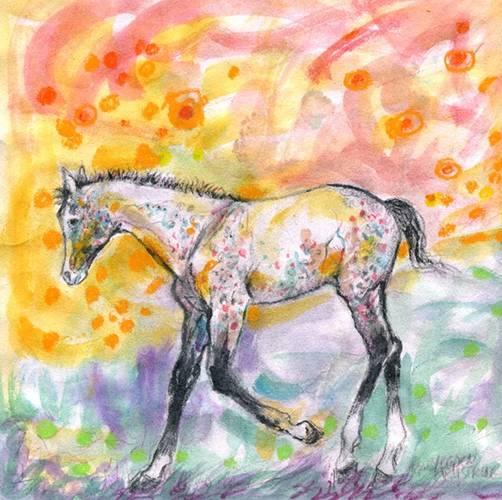

The French Ministry of Culture page dedicated to Lascaux One hears their voices calling, but can't make out the words. But today, looking at the Pech-Merle handprints, one gets the spooky sense of people reaching out as they fall away into the chasm of time. What were they trying to say with those? What were Cro-Magnon painters ever trying to say? Maybe they were reaching through the cave wall to the spirit world beyond. More striking than the animals themselves, however, are the half-dozen hands that surround them-negative handprints of the artists, outlined in black. Two hours southeast of Lascaux, a cave called Pech-Merle is open to the public, and it contains, among other things, a very nice pair of ponies. Prehistoric paintings don't have to be masterpieces to be moving the mystery's the thing. The line protruding from its snout may represent a spear-but because Lascaux is littered with enigmatic symbols, one can't be sure.

There is a hint of sadness in its expression. It's all black, but its face is fully rendered the guide calls attention to the eyebrows. Two more giant bulls march up the right wall, each different. Near the rear they encounter a group of stags and another bull. An enormous bull leads a herd of small horses along the left wall. Then a sense of motion takes over, motion on a large scale combined with fine detail-a prehistoric pageant. The first impression is one of richness: The walls are covered with paintings. The people who built it in the 1970s and 1980s reproduced the shape of the walls, inch by inch, with cement molded onto a metal frame, and the artists who painted the replica used the same materials as their Cro-Magnon predecessors. It seems like a real cave, albeit a well-groomed one. But it is here in the Hall of the Bulls that Lascaux II creates an indelible impression. Passing through that doorway, one plunges into a half-light alive with bulls.īeyond lies the Axial Gallery, with its leaping red-and-black cow and its horses marching single file.

A small model of their oak scaffolding stands near the exit. At Lascaux, unlike at most other caves, the artists did not limit themselves to simple line drawings in black or red they colored in the animals with red, brown, and yellow. The second antechamber exhibits the painters' paraphernalia-the sandstones they hollowed out and filled with reindeer tallow to use as lamps, the animal-hair brushes, the pigments. In Lascaux II, the guide says reassuringly, "you are allowed to breathe." More than a million people visited Lascaux between 19 before the cave was closed to tourists. In the first of two antechambers, the guide points to a map of the real thing, explaining why visitors are not allowed to see it: The carbon dioxide in their exhalations would react with the cave wall and cover the paintings with a layer of white calcite. It is set into the hillside a couple of hundred yards from the real cave. Those two chambers, which contain 90 percent of the paintings in Lascaux, have been reproduced in the concrete bunker called Lascaux II. Twenty-two yards farther, however, they entered what's now called the Axial Gallery, a passage so narrow that the flickering light of their oil lamp bounced off potbellied horses and a leaping cow. They did not at first notice the herds of animals around them. When they got back on their feet they were in what is now called the Hall of the Bulls.

Lascaux was discovered in September 1940 by several teenage boys who, while chasing their dog, had tumbled down a hole made by a fallen tree. That's not open to the public either-but a faithful replica is, and as the Michelin guidebook says, it's worth a detour. And then, of course, there is the Lascaux cave, a couple of hundred miles to the west in Dordogne. There are some in Chauvet Cave of southern France, but tourists can't see them: Discovered in 1994, the cave is still reserved for scientists. As with other art, true Cro-Magnon masterpieces are the exception. Guides who lead tours of caves painted by our prehistoric ancestors like to suggest that visitors are in the presence of masterpieces.


 0 kommentar(er)
0 kommentar(er)
